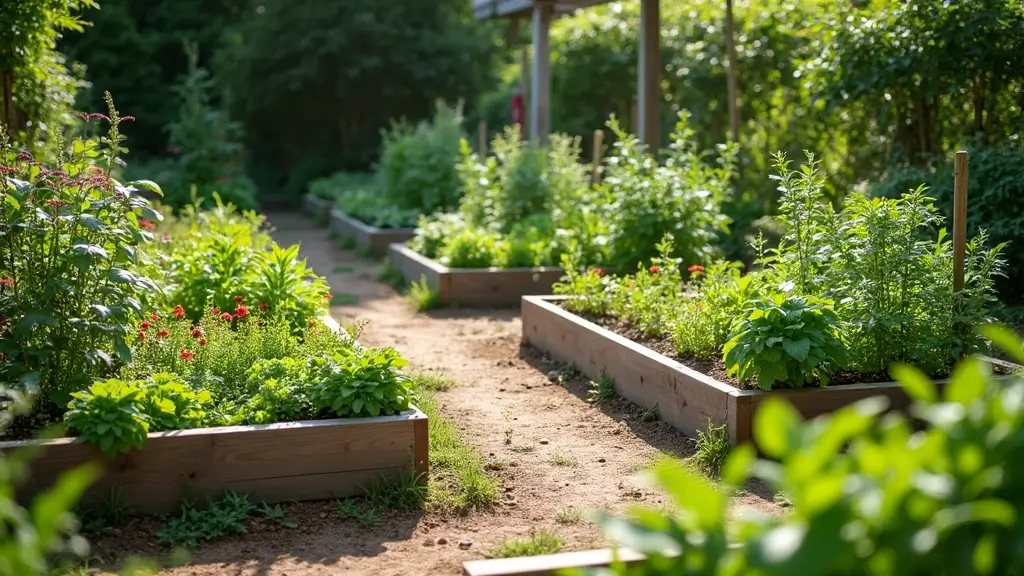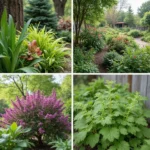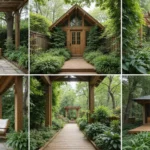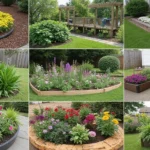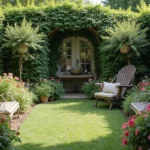Gardening in small spaces doesn’t mean sacrificing your green thumb!
With raised garden beds, you can cultivate a delightful vegetable paradise right in your backyard or on your balcony.
These layouts maximize growing potential without overwhelming your space, letting you enjoy fresh produce and beautiful blooms.
Get ready to explore a variety of layouts that simplify planting and optimize your gardening experience. Whether you’re a novice or a seasoned gardener, these creative designs will inspire you to create your ideal green sanctuary.
1. Vertical Stacking Beds
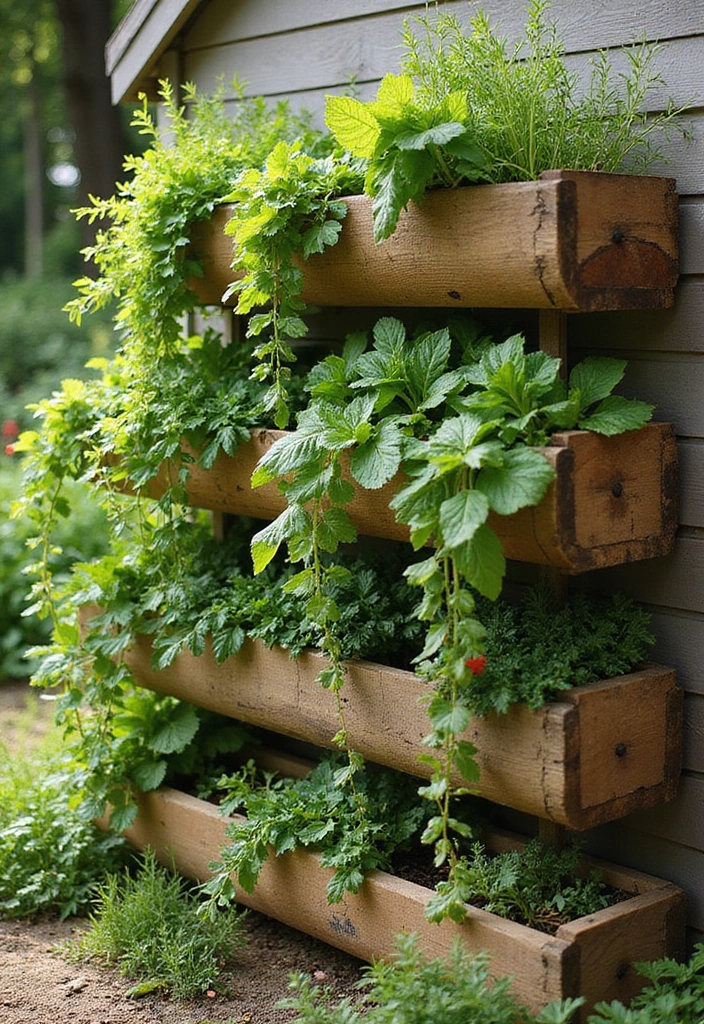
Vertical stacking beds are a fantastic way to save ground space while maximizing your yield.
These beds utilize vertical space, allowing you to grow multiple layers of plants.
You can choose tiered wooden boxes or even stack planters made of recycled materials.
This design not only adds visual interest to your garden but is also great for growing vining plants like peas and cucumbers that can trail down from the upper tiers.
Tips:
– Ensure adequate drainage to prevent root rot.
– Opt for lightweight soil mixes to reduce stress on the structure.
– Position taller plants on the top levels to maximize sunlight exposure.
Consider incorporating herbs that cascade down for a charming look!
2. Corner Raised Bed Designs
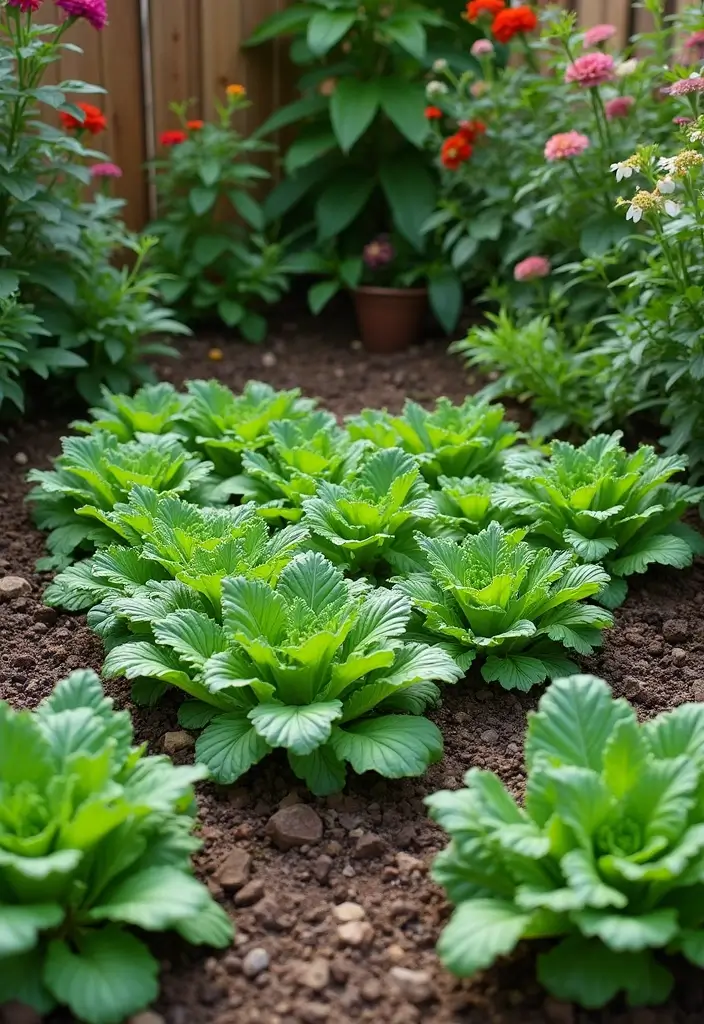
Utilizing those often-overlooked corners in your yard can transform them into productive gardening spots.
Corner raised beds can be designed in a triangular or L-shape, fitting snugly into the corner of your garden.
This layout provides ample room for planting while keeping things compact and manageable.
You might grow fast-growing herbs and leafy greens like spinach and lettuce, which benefit from a well-defined growing space.
Tips:
– Use corner beds to create a stunning focal point in your garden.
– Choose companion planting techniques to enhance growth and deter pests.
– Regularly rotate crops to maintain soil health.
3. Ladder Planters
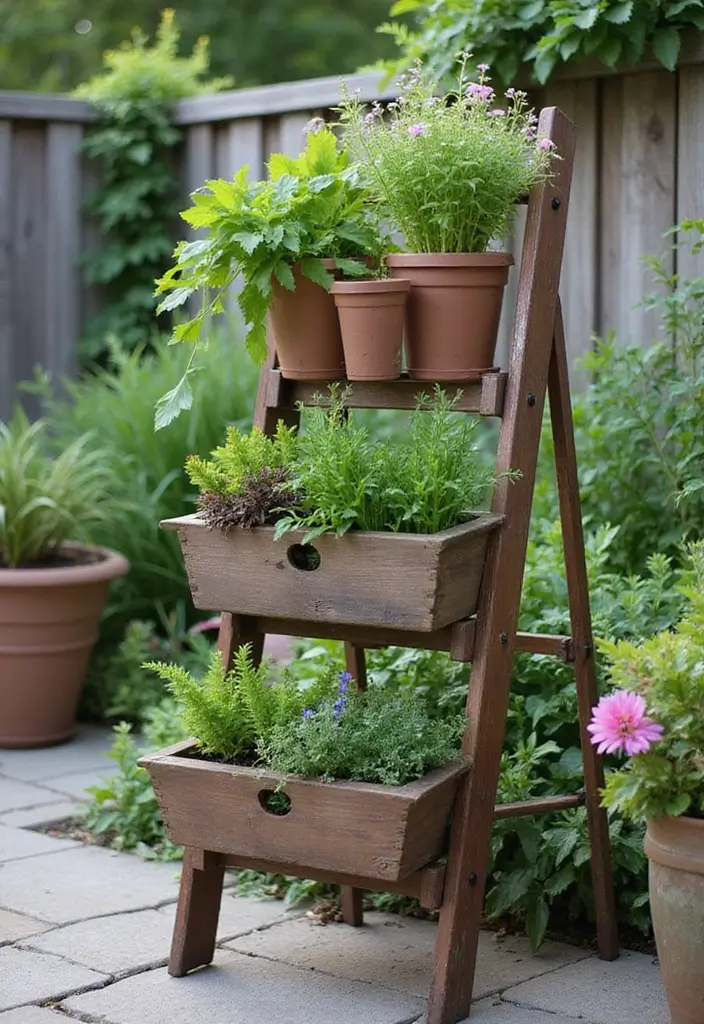
Ladder planters are the perfect solution for small spaces, offering a stylish and practical way to grow plants vertically.
These designs resemble a ladder, with shelves for pots.
You can fill each shelf with a different type of herb or flower, providing an aesthetically pleasing display.
This layout is especially good for herbs such as basil, thyme, and mint, which can thrive close together.
Tips:
– Choose a sturdy material to ensure durability, like treated wood or metal.
– Ensure the planters have proper drainage holes to keep roots healthy.
– Group plants by watering needs for easier maintenance.
4. Grid Layout Beds
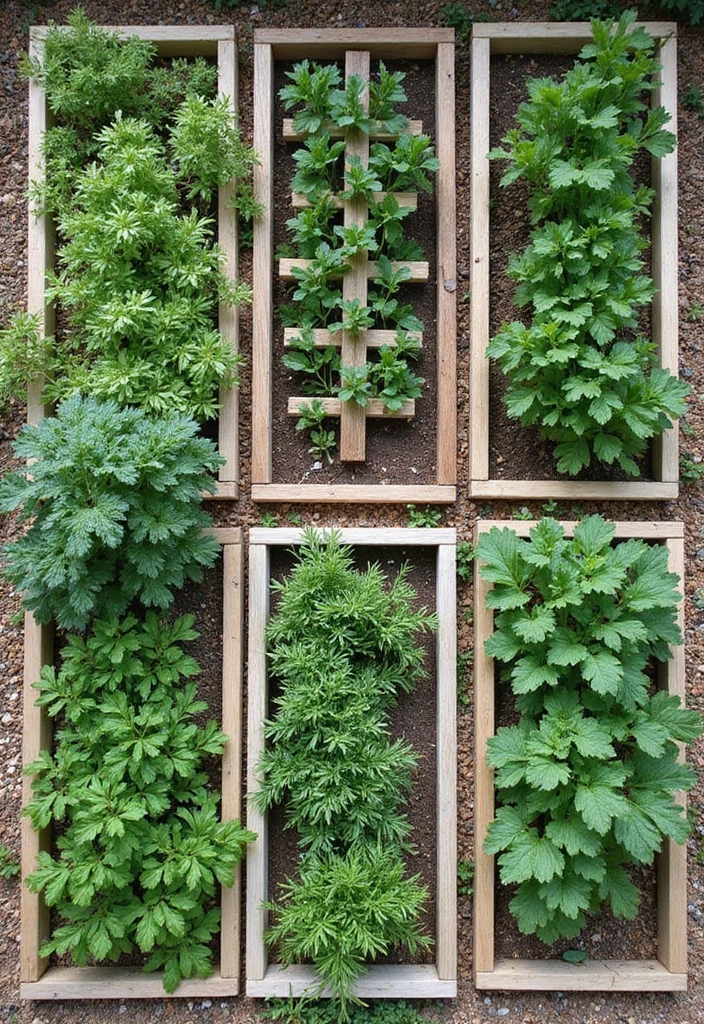
Grid layout beds are all about efficiency in planting.
This design uses a grid pattern to maximize square footage while keeping plants organized.
Each square can be dedicated to a specific plant type, making it easy to manage and maintain.
You can optimize growing conditions by grouping plants with similar light and water needs together.
Tips:
– Use a trellis on one side for climbing plants, increasing vertical space.
– Implement crop rotation to maintain soil fertility.
– Mark your grid squares with labels for easy identification.
5. Container Raised Beds
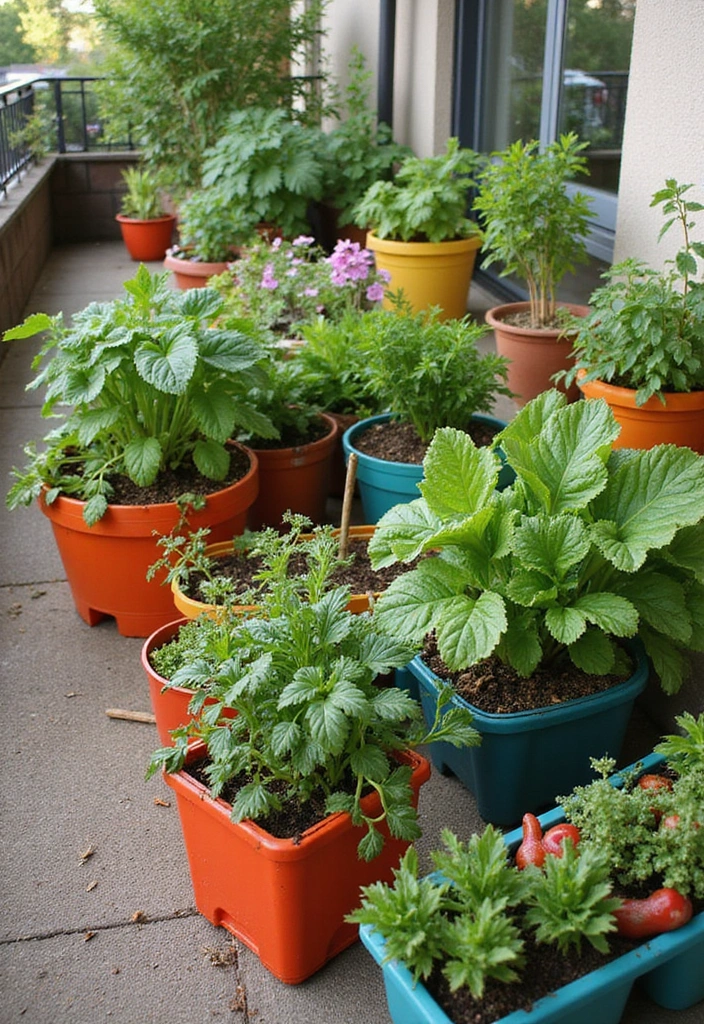
Container raised beds are incredibly versatile and can be placed almost anywhere, from patios to balconies.
Using large planter boxes or even repurposed containers allows for easy mobility and a customizable layout.
You can mix and match different containers for a more dynamic gardening experience.
This design is perfect for growing smaller vegetables like radishes and cherry tomatoes, which flourish in confined spaces.
Tips:
– Ensure containers have proper drainage to prevent waterlogged roots.
– Use quality potting soil for optimal growth.
– Experiment with different container sizes for varied planting options.
6. Half-Round Beds

Half-round raised beds are an innovative way to use space efficiently while creating a striking visual element in your garden.
These semicircular beds can fit snugly against walls or fences, allowing for easy access from the front.
They are perfect for planting a variety of crops, such as herbs and compact vegetables, maximizing both space and yield.
Tips:
– Position taller plants toward the back for optimal sunlight.
– Use recycled materials to build your beds for a sustainable approach.
– Include pathways around your beds for better accessibility.
7. Vertical Wall Gardens
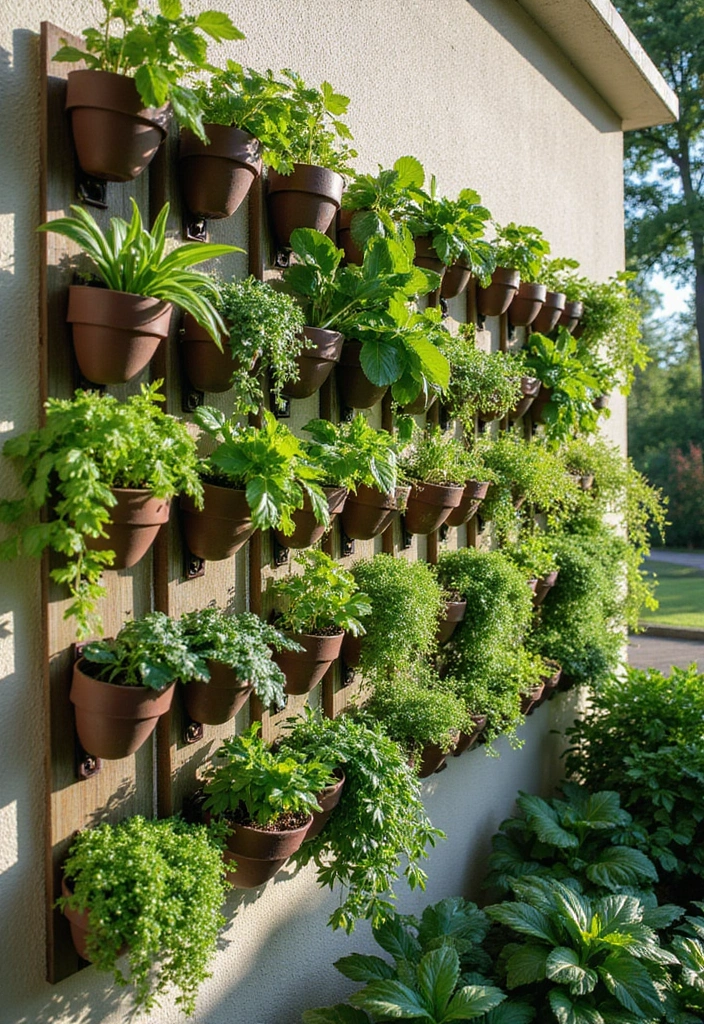
Vertical wall gardens offer a stunning way to utilize wall space, turning a bland area into a lush vertical oasis.
Using wall-mounted planters or pockets, you can create a living wall filled with herbs, succulents, or even small vegetables.
This layout is not only space-saving but also adds a unique aesthetic to your garden or home.
Tips:
– Ensure the wall material can support the weight of the plants and soil.
– Use a drip irrigation system for easy watering.
– Select plants that thrive in vertical conditions for the best results.
8. U-Shaped Beds
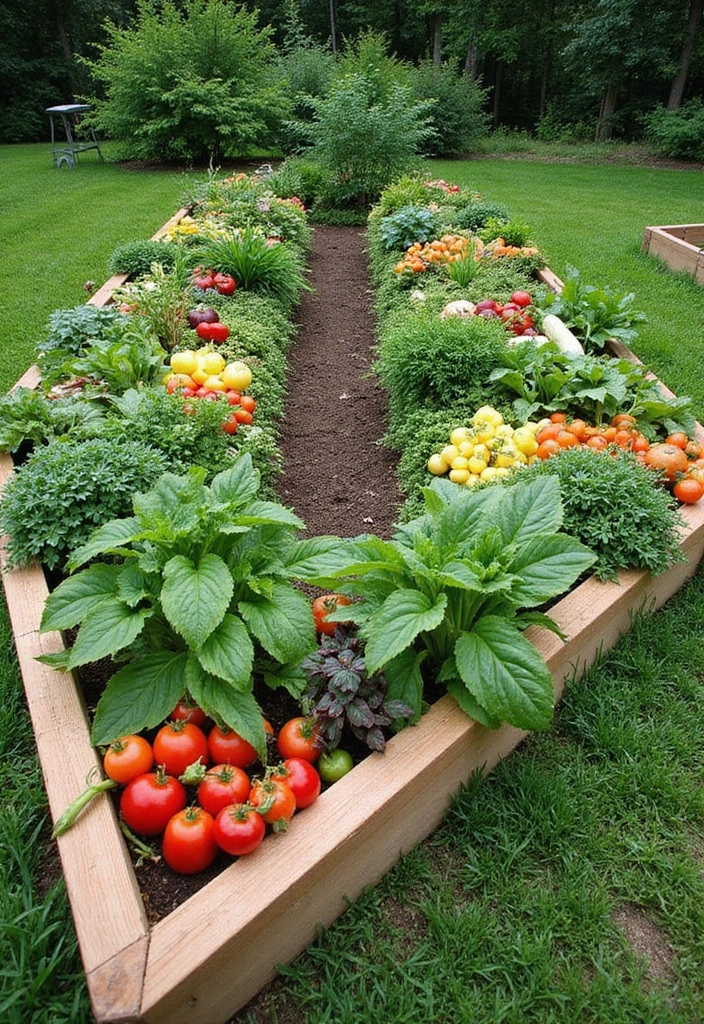
U-shaped raised beds create a unique and spacious planting area while promoting easy access from all sides.
This design is excellent for larger gardening projects, allowing you to cultivate a variety of plants without the hassle of reaching over obstacles.
You can dedicate sections of the bed to different crops, making it a versatile option for small space gardeners.
Tips:
– Use mulch to retain soil moisture and suppress weeds.
– Plan for a wide enough path in the center to comfortably access all areas of the bed.
– Incorporate companion planting for enhanced growth.
9. Tiered Planters
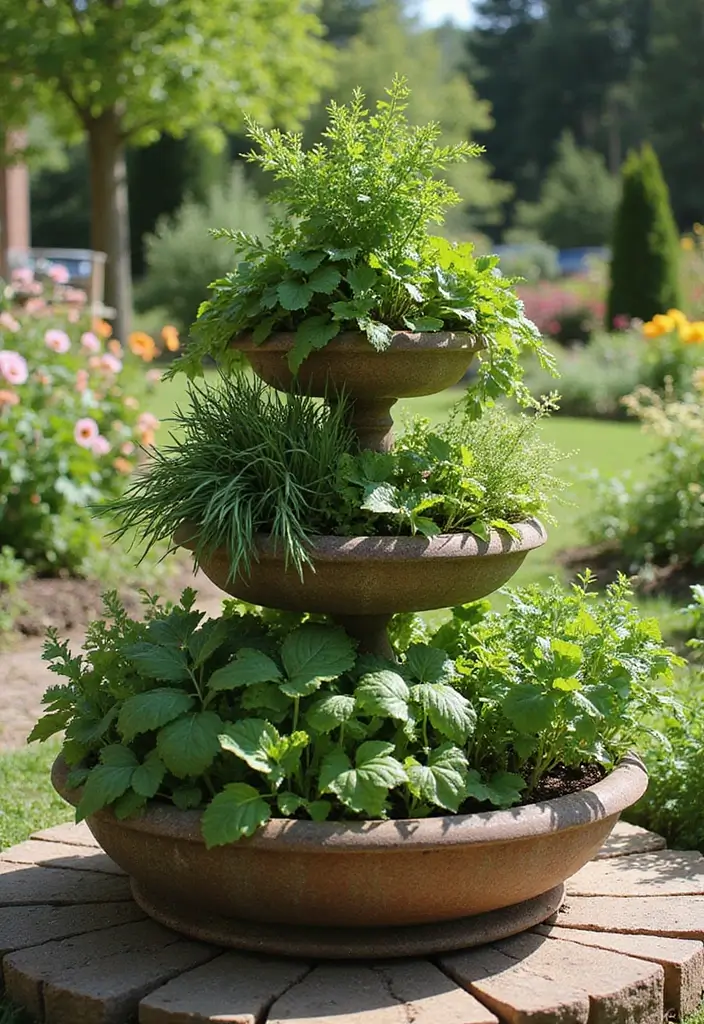
Tiered planters bring a sense of elegance and organization to your garden.
These multi-level structures provide ample space for various plants while allowing for efficient space use.
You can plant herbs on the top tier and larger vegetables on the bottom, promoting healthy growth at different levels.
Tips:
– Ensure good light exposure for all tiers.
– Rotate crops periodically to maintain soil health.
– Use a high-quality potting mix for optimal plant growth.
Tiered planters not only maximize your space but also add a touch of elegance to your garden! Elevate your planting game by layering herbs and veggies for a thriving, organized oasis.
10. Hexagonal Beds
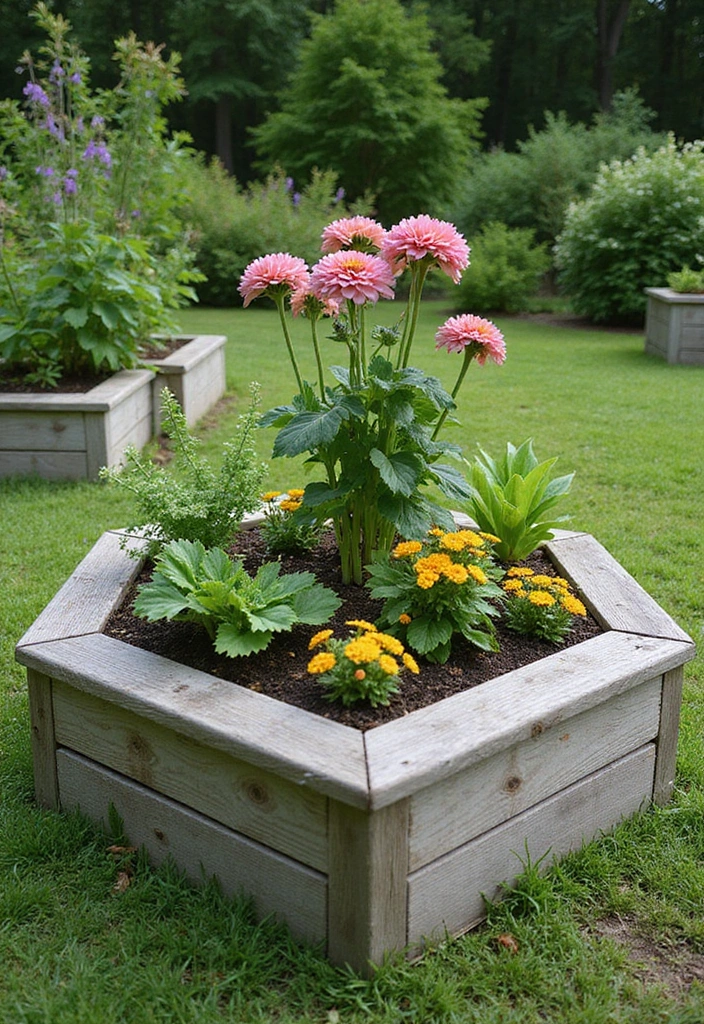
Hexagonal raised beds provide a fresh twist on traditional layouts, offering an eye-catching alternative.
These unique shapes can fit snugly into corners or stand alone as a focal point in your garden.
You can experiment with different sizes, and you might find they work well for companion planting, enhancing productivity.
Tips:
– Use attractive materials to enhance the visual appeal.
– Plan for adequate sunlight exposure for all sides.
– Incorporate a mix of flowers and vegetables for biodiversity.
11. Raised Bed Columns
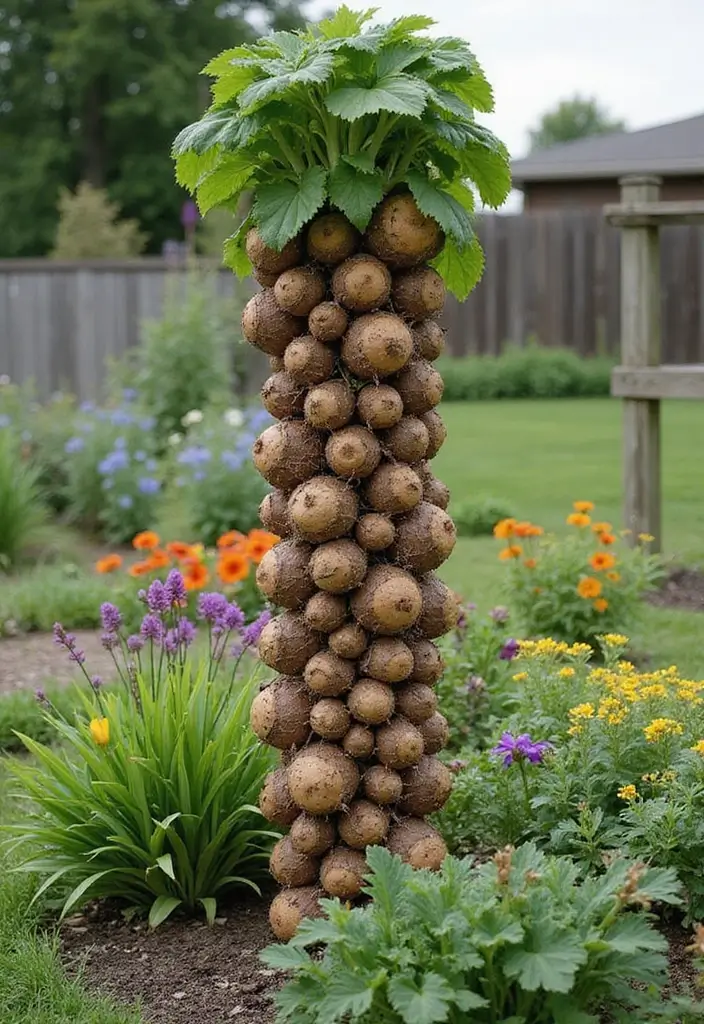
Raised bed columns are a quirky solution for small spaces that need a little extra flair.
These standalone structures feature vertical columns filled with soil, perfect for growing root vegetables like carrots and beets.
The design helps with airflow and drainage, promoting healthy plant growth.
Tips:
– Choose a sturdy design to withstand weight.
– Plant smaller varieties that thrive in confined spaces.
– Use a well-draining soil mix to prevent waterlogged roots.
12. Spiral Herb Garden
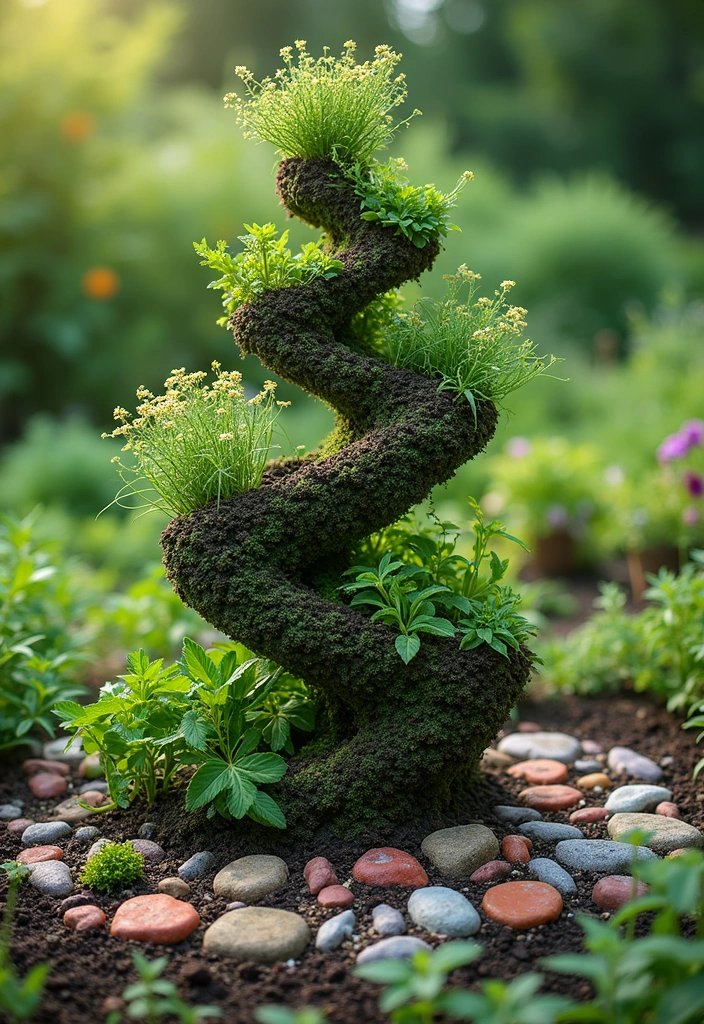
A spiral herb garden is a fun and visually appealing way to cultivate herbs in a limited area.
This design spirals upward, allowing you to plant various herbs at different heights, maximizing light exposure and space efficiency.
It’s not only a practical layout but also an attractive addition to any garden.
Tips:
– Ensure adequate drainage, especially in the lower levels.
– Use herbs that have varying sun and water requirements for the best results.
– Consider adding decorative stones or plants for added interest.
13. Pallet Planters
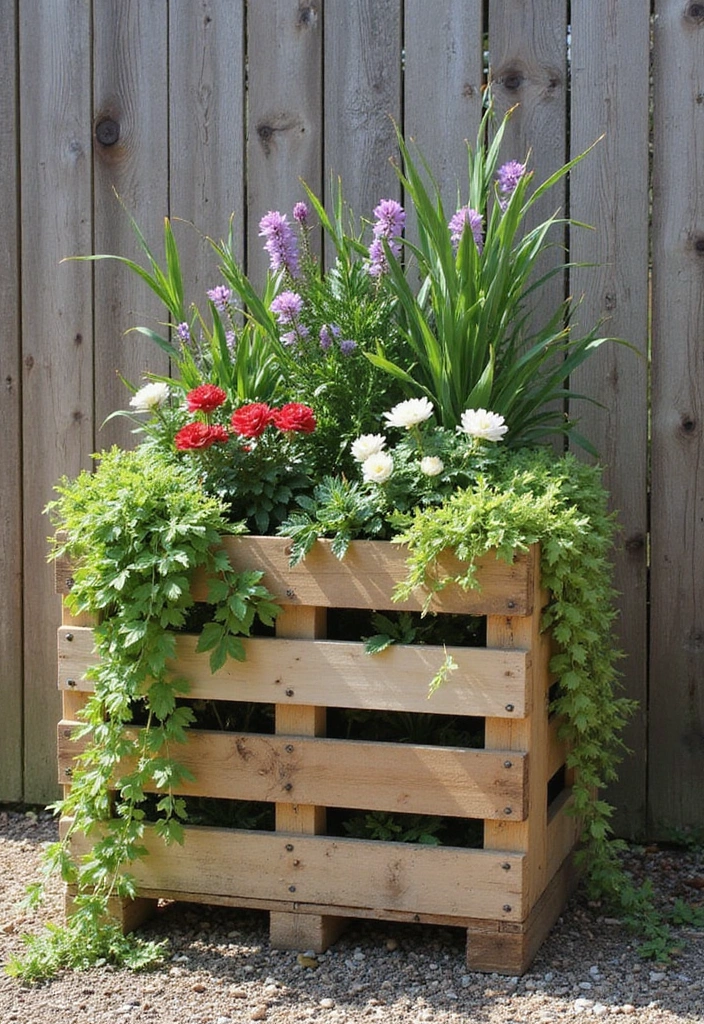
Pallet planters are a clever and eco-friendly way to create raised beds with a rustic charm.
Using old pallets, you can construct a vertical planter that can hold an array of plants.
These can work wonderfully for trailing plants, providing an enchanting look.
Tips:
– Ensure the pallets are in good condition without toxic chemicals.
– Consider lining the inside with landscaping fabric to hold soil.
– Position it against a wall or fence for added support.
14. Mixed-Use Raised Beds
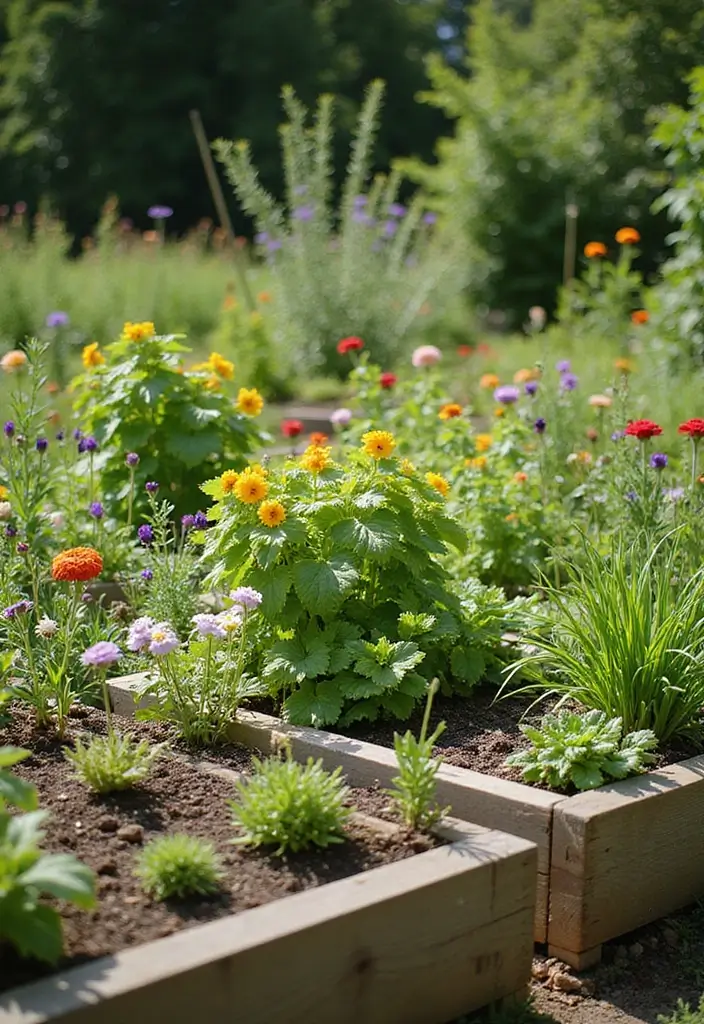
Mixed-use raised beds allow for a variety of plants to flourish together.
By incorporating both vegetables and flowers, you can enhance biodiversity while making the most out of your space.
The flowers attract pollinators, promoting a healthier garden ecosystem.
Tips:
– Use companion planting techniques to enhance growth and deter pests.
– Regularly monitor plants for signs of disease or pests.
– Rotate plant types each season to maintain soil fertility.
15. Semi-Circular Beds
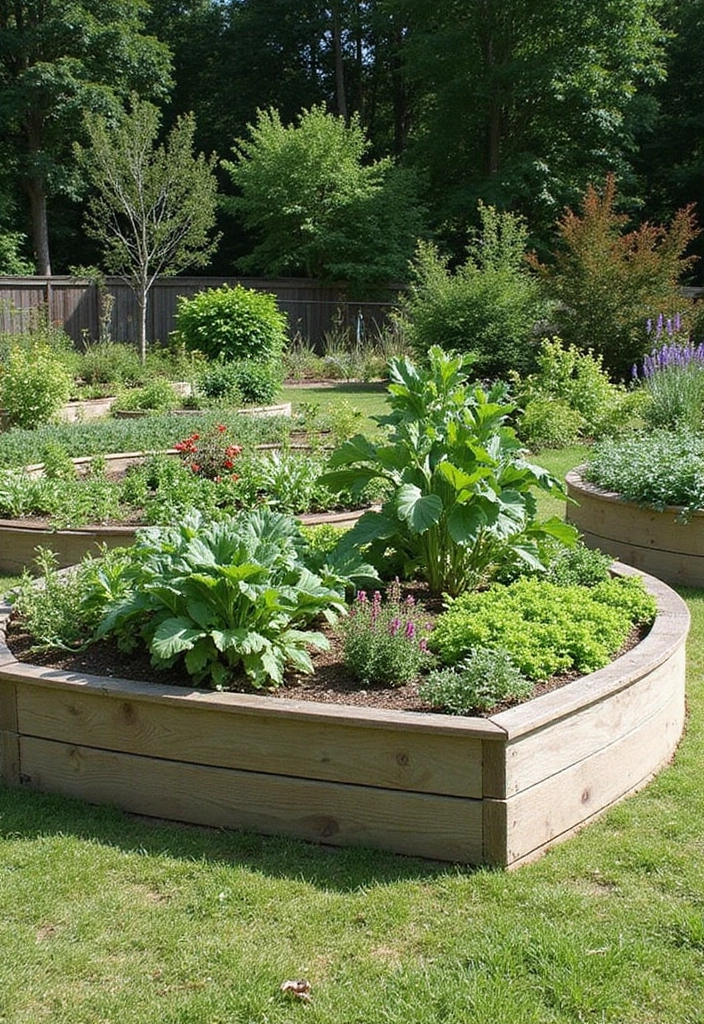
Semi-circular raised beds offer a stylish and functional layout for small gardens.
This design allows easy access from the outer edges, making it practical and visually appealing.
You can fill the beds with a variety of crops, perhaps dedicating sections to your favorite herbs or vegetables.
Tips:
– Use quality soil and compost for optimal growth.
– Pair taller plants in the back for a layered look.
– Regularly check for pests and diseases to ensure healthy plants.
16. Portable Raised Beds
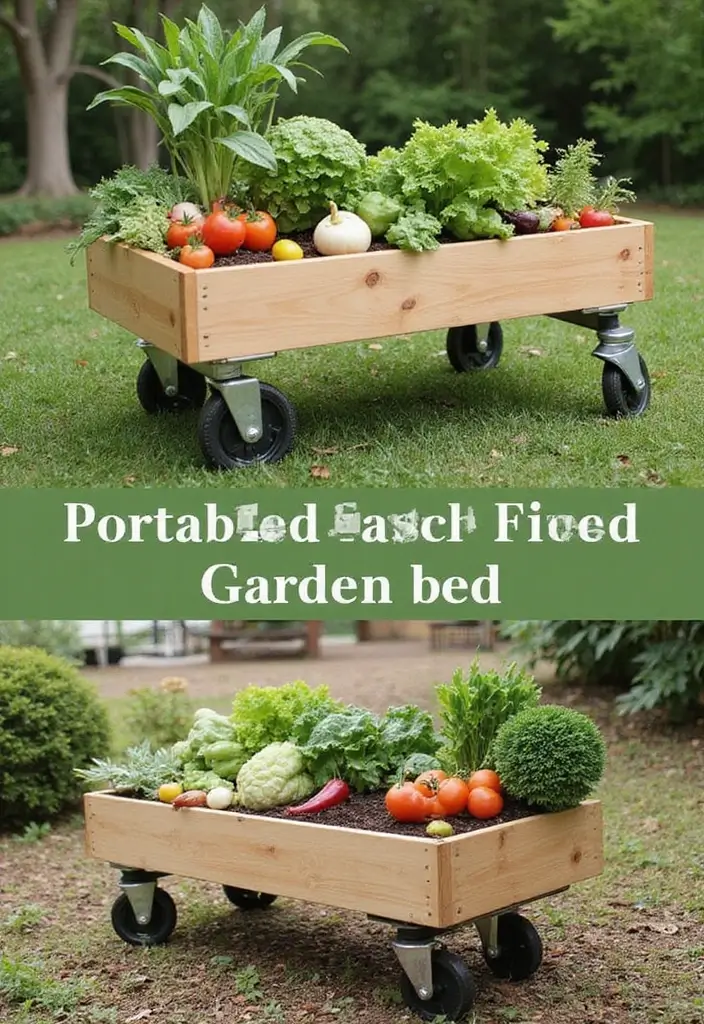
Portable raised beds are perfect for gardeners who like to change things up!
These beds can be easily moved to follow the sun or simply rearranged for aesthetic reasons.
Using lightweight materials, you can create a productive growing space that offers flexibility.
Tips:
– Choose a sturdy base for stability when moving.
– Ensure drainage holes are included.
– Consider using wheels for easy mobility.
17. Recycled Material Beds
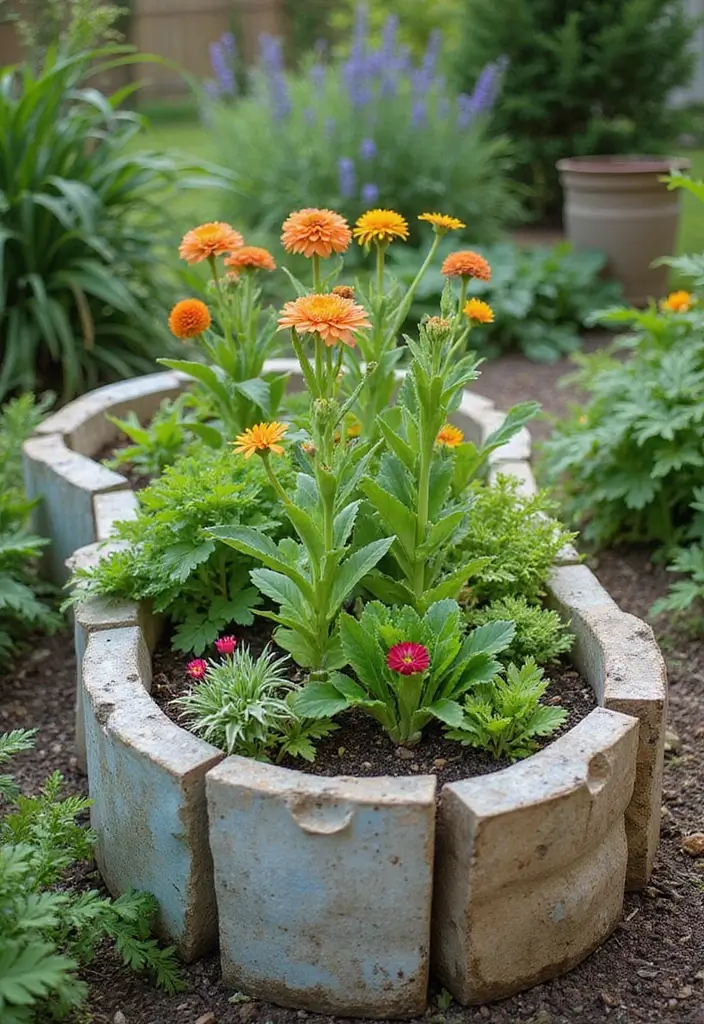
Recycled material raised beds are a sustainable option that can also be quite beautiful.
Using materials like old bricks, wood, or tires, you can create unique beds that stand out in your garden.
This eco-friendly approach not only helps the environment but can also save money.
Tips:
– Ensure all materials are safe and free of harmful chemicals.
– Mix and match different materials for an interesting design.
– Regularly inspect for wear and maintain the structure.
Create beauty from waste! Recycled material raised beds not only benefit the environment but also add character to your garden. Mix and match for a unique touch that’s kind to your wallet and the planet!
18. Rectangular Gardens
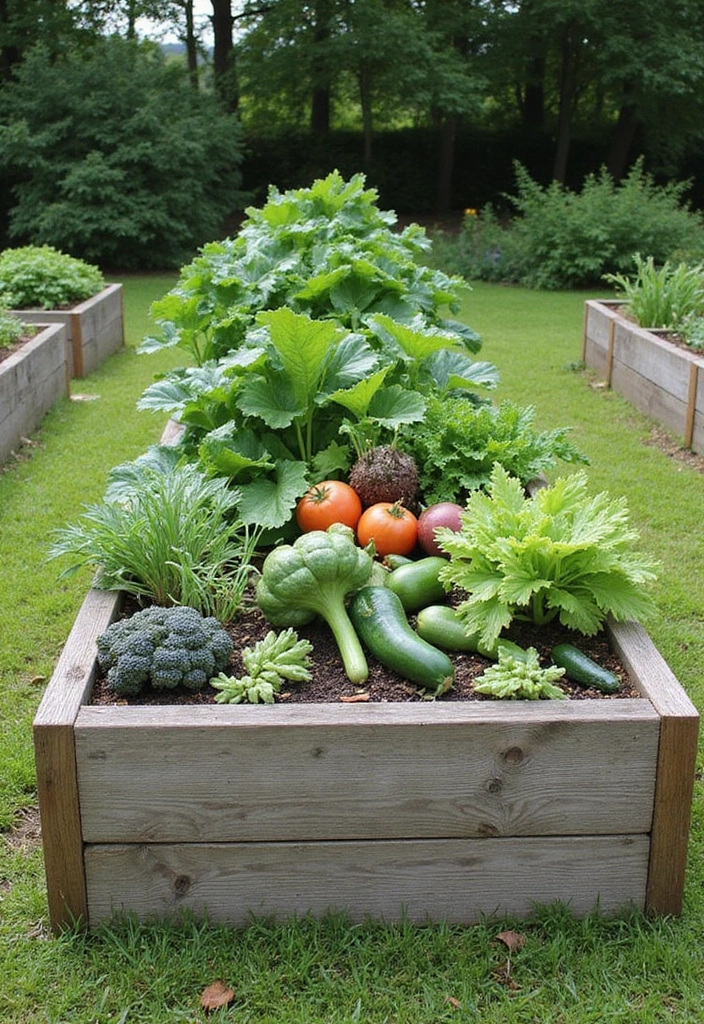
Rectangular raised garden beds are a classic choice that maximizes planting space while keeping things organized.
These beds can be positioned side by side or in a row, offering a structured and visually appealing layout.
Consider dedicating sections for specific crops to promote efficient planting and harvesting.
Tips:
– Use mulch in pathways to reduce weeds.
– Optimize sunlight exposure for all plants.
– Plan for easy accessibility to all sides.
19. Modular Raised Beds
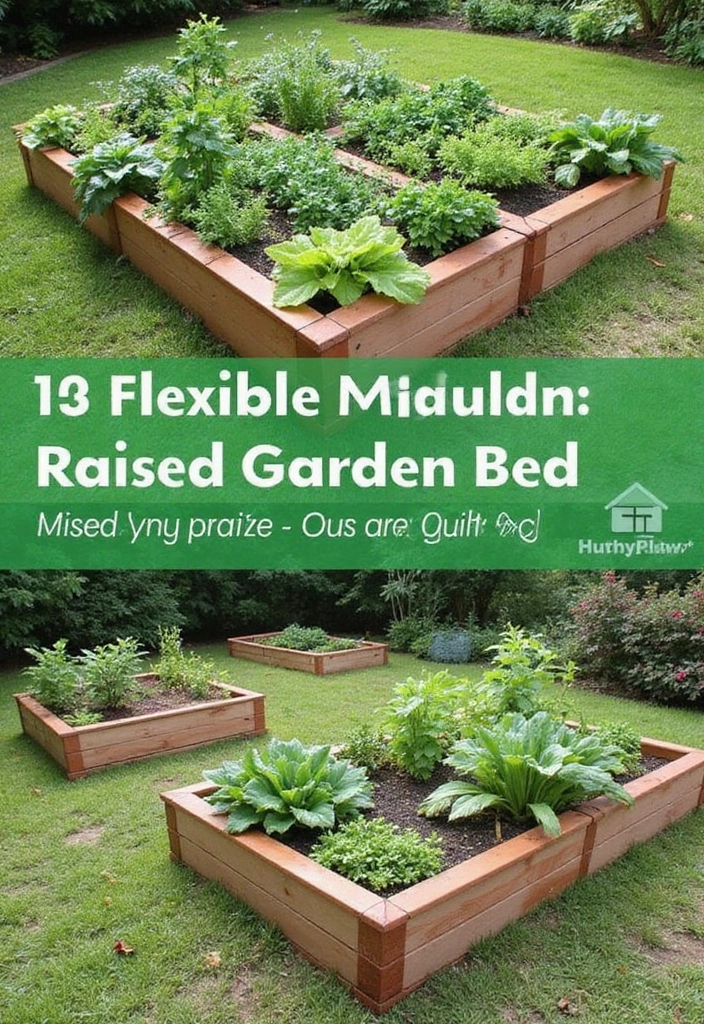
Modular raised beds offer a customizable solution for gardeners looking for versatility.
These beds can be rearranged or expanded as your gardening needs change, making them perfect for small spaces.
Modular designs allow you to experiment with layouts and plant combinations.
Tips:
– Use high-quality materials for durability.
– Plan your layout before assembly for optimal function.
– Utilize crop rotation to maintain soil health.
20. Triangular Beds
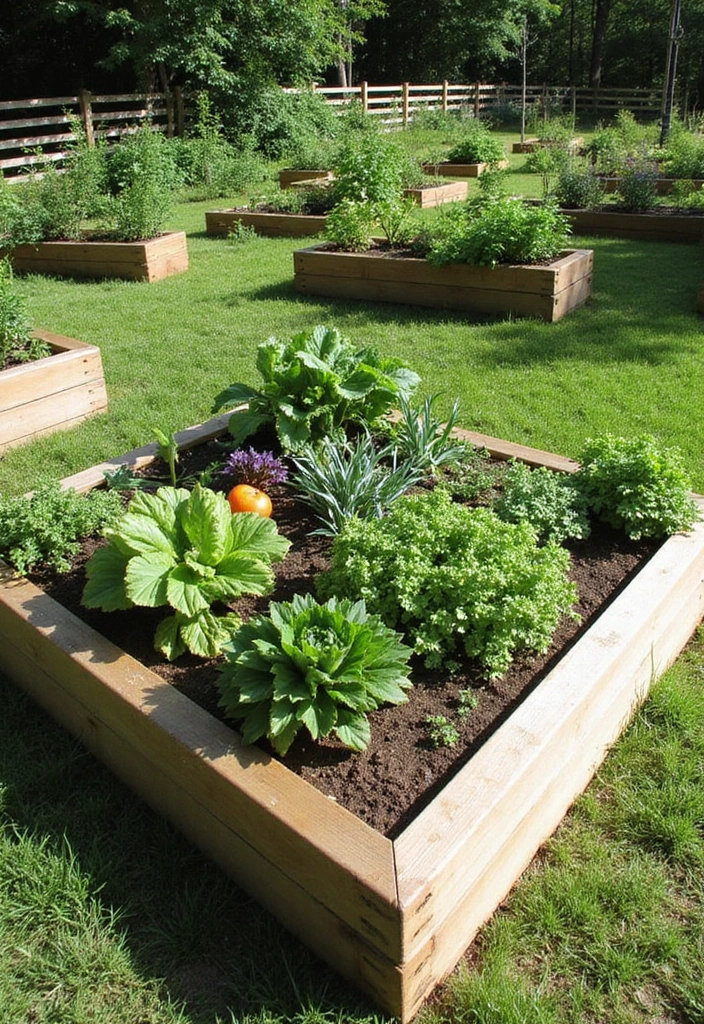
Triangular raised beds are a unique shape that can fit into smaller areas while still providing plenty of growing space.
This design allows for effective space utilization while adding a touch of creativity to your garden.
You can plant a variety of crops, making it an efficient choice for small space gardening.
Tips:
– Position the bed in a sunny spot to ensure all plants receive adequate light.
– Include pathways for maintenance access.
– Rotate crops to prevent soil depletion.
21. Community Garden Beds
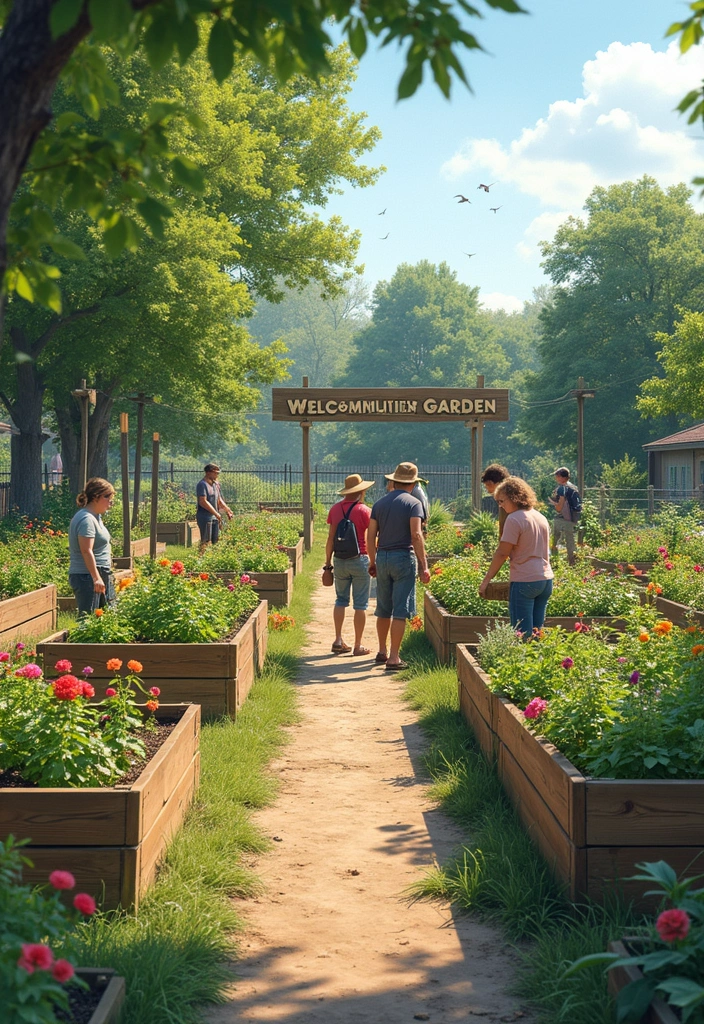
Community garden beds foster collaboration and provide a sense of togetherness among gardeners.
These shared spaces allow multiple gardeners to plant and maintain their plots, promoting community involvement.
Consider creating sections for different vegetables, encouraging variety and diversity in planting.
Tips:
– Establish clear guidelines for maintenance and care.
– Organize regular gardening events to strengthen community bonds.
– Rotate crops among plots to maintain soil health.
22. Ornamental Raised Beds
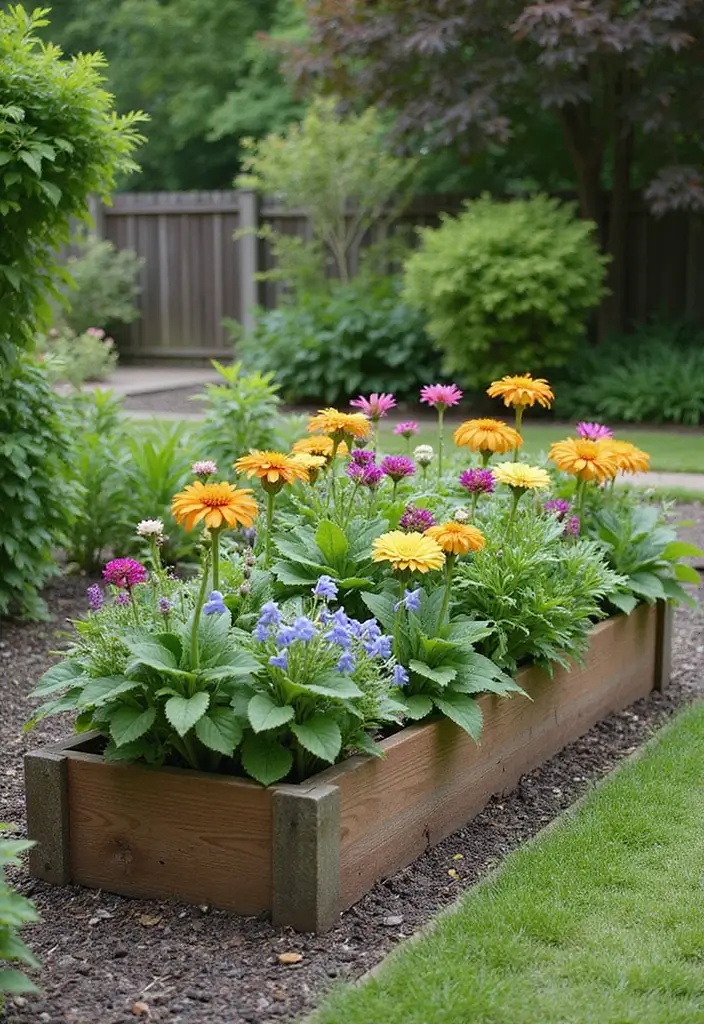
Ornamental raised beds combine beauty with functionality, creating stunning focal points in your garden.
By integrating decorative stones, bricks, or wood, you can design picturesque beds filled with colorful flowers or vegetables.
These beds are perfect for enhancing curb appeal while also providing a space for gardening.
Tips:
– Mix flowering plants with vegetables for a stunning contrast.
– Use high-quality materials to ensure durability.
– Regularly maintain beds to preserve their beauty and functionality.
23. Slope-Savvy Beds
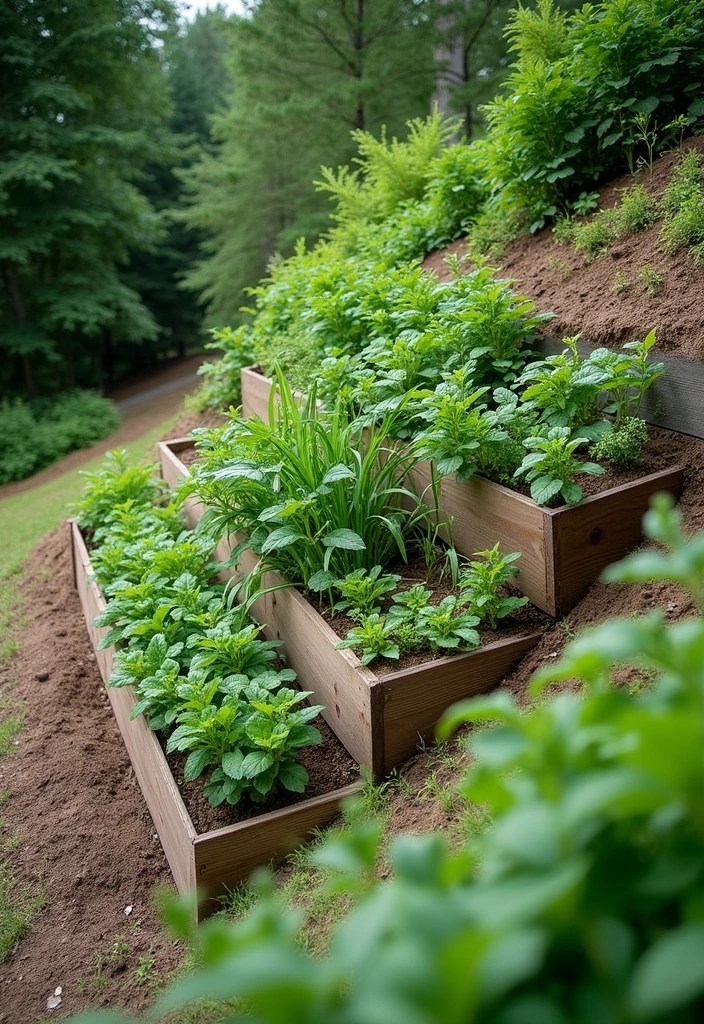
For gardeners dealing with a sloped yard, slope-savvy raised beds are the solution.
These beds can be built into the slope, allowing for effective drainage and preventing soil erosion.
You can plant various crops, ensuring they receive adequate sunlight and water.
Tips:
– Build retaining walls for additional support if necessary.
– Choose plants that thrive on slopes, such as herbs and native flowers.
– Regularly check for erosion and maintain the structure.
24. Dual-Level Beds
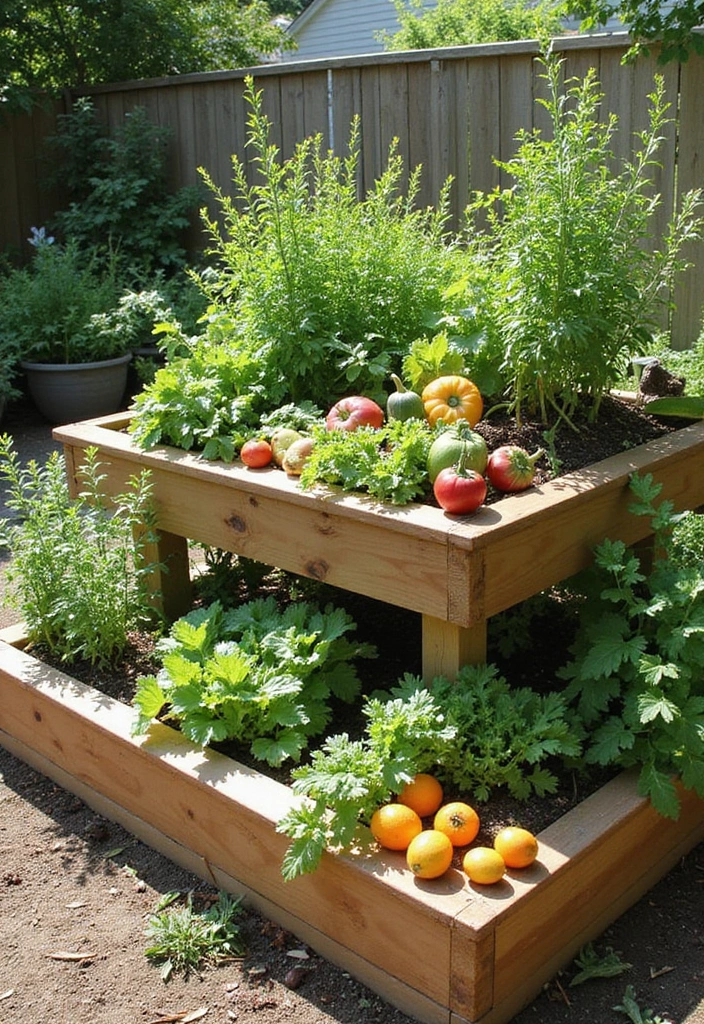
Dual-level beds are a creative solution for maximizing planting space in small gardens.
With one level raised above another, you can grow different types of plants that require varying sun exposure.
This design creates an attractive visual dynamic and encourages biodiversity among your plants.
Tips:
– Ensure both levels have suitable drainage.
– Regularly check for pests and diseases between levels.
– Rotate crops to maintain optimal soil health.
25. Edible Flower Beds
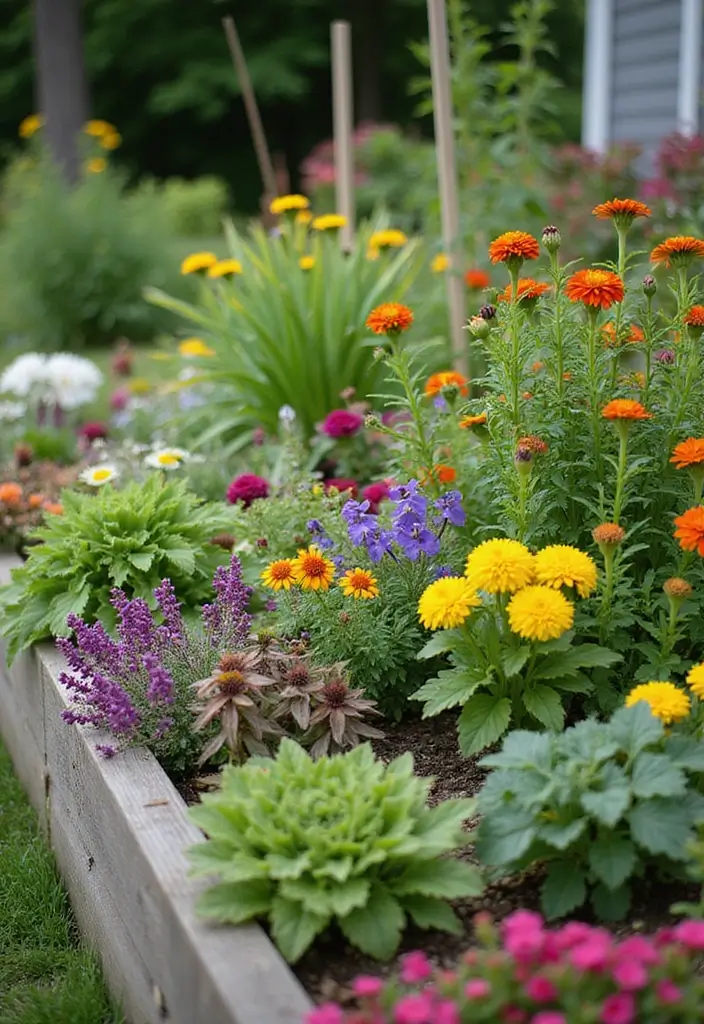
Edible flower beds are a fun way to combine beauty with utility in your garden.
By planting vegetables alongside flowers, you can create a visually stunning garden that also serves a purpose.
Flowers like nasturtiums and calendula not only add color but can also enhance the flavors of your dishes.
Tips:
– Ensure flowers are safe for consumption.
– Use companion planting techniques for better growth.
– Regularly prune flowers to encourage healthy growth.
26. DIY Trellis Beds
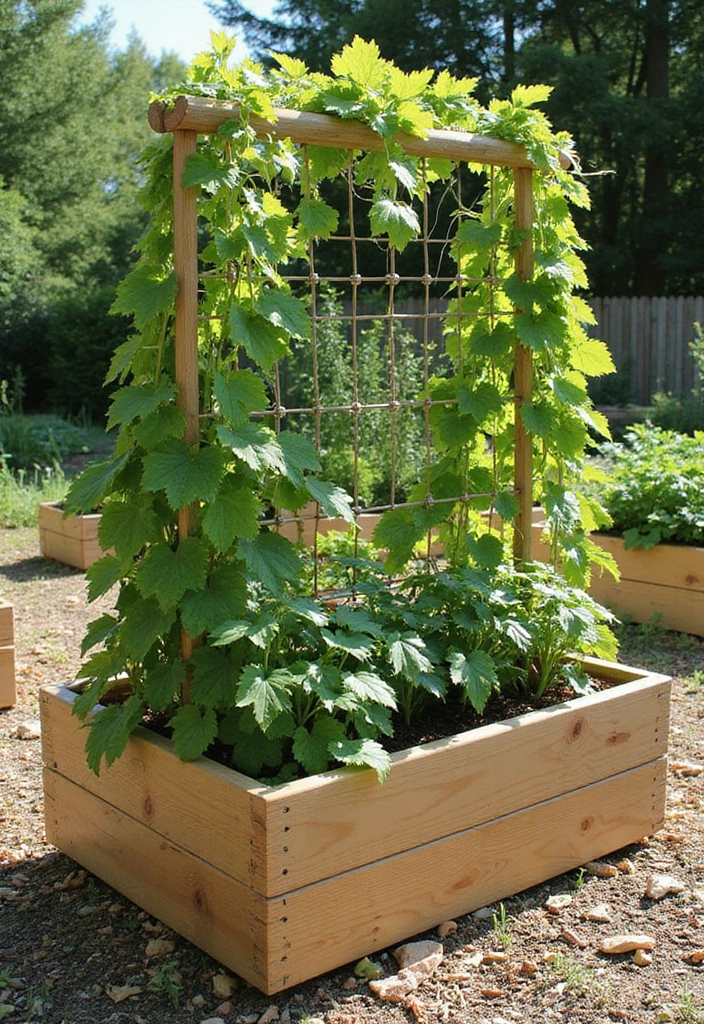
Trellis beds combine raised gardening with vertical gardening, allowing vining plants to flourish.
You can build a trellis into your raised bed, providing support for plants like tomatoes, cucumbers, and beans.
This design maximizes yield while keeping your garden organized and easy to maintain.
Tips:
– Ensure the trellis is sturdy enough to support heavy fruits.
– Rotate crops regularly to avoid soil depletion.
– Prune plants regularly for healthy growth.
27. Wildlife-Friendly Beds
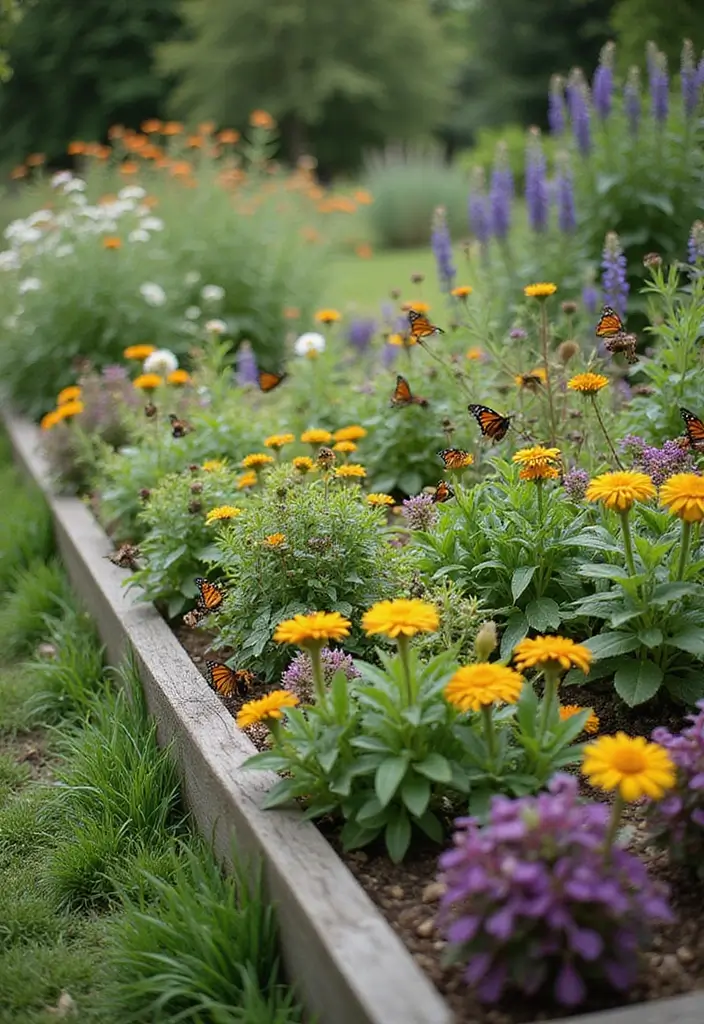
Wildlife-friendly raised beds create a harmonious environment for both plants and local creatures.
You can incorporate native plants that attract pollinators and beneficial insects while also providing food and shelter for wildlife.
This approach enhances biodiversity and creates a flourishing ecosystem in your garden.
Tips:
– Choose plants that are native to your area for sustainability.
– Avoid chemical pesticides to protect beneficial insects.
– Incorporate elements like stones or logs to provide habitats for wildlife.
28. Biodegradable Raised Beds

Biodegradable raised beds are an eco-friendly option that adds nutrients back into the soil as they decompose.
Made from materials like cardboard or straw bales, these beds offer a sustainable gardening solution for small spaces.
They can be filled with soil and compost, allowing plants to thrive while improving soil health.
Tips:
– Ensure the materials are free from harmful chemicals.
– Monitor moisture levels as these beds can dry out faster.
– Regularly replenish with organic matter as they decompose.
29. Minimalist Raised Beds
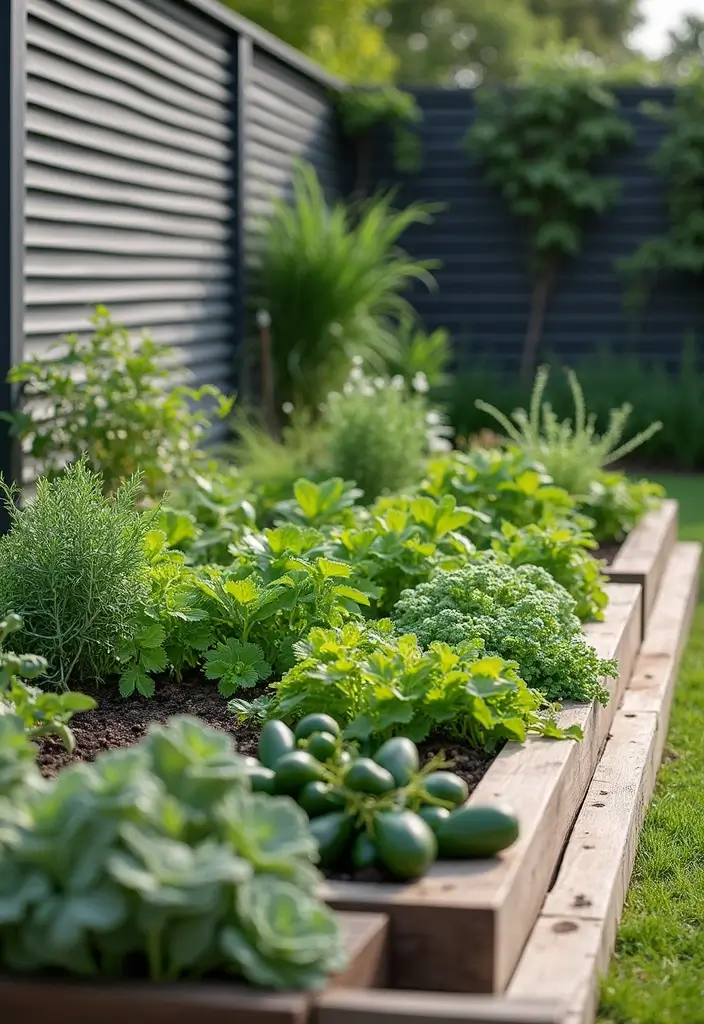
Minimalist raised beds focus on simplicity and functionality.
Using clean lines and basic materials, these beds provide a sleek look while remaining practical for gardening.
Perfect for modern spaces, they can be easily incorporated into any garden design.
Tips:
– Use high-quality materials for durability.
– Choose a uniform soil mix for healthy growth.
– Plan for easy access to all sides for maintenance.
Simplicity is the ultimate sophistication—especially in gardening! Minimalist raised beds not only elevate your space but also make plant care a breeze. Keep it clean, functional, and beautiful!
30. Grassy Raised Beds

Grassy raised beds offer a unique twist, providing a natural look while encouraging wildlife habitats.
By incorporating grass into your raised bed design, you create a soft transition between gardening and landscaping.
These beds are excellent for wildlife and can also promote healthier soil.
Tips:
– Choose grass types that are suitable for your climate.
– Monitor water levels as grass can require regular maintenance.
– Combine with flowering plants to create a visually appealing design.
Transform your garden with grassy raised beds! They not only create a stunning landscape but also support wildlife and enrich your soil. Embrace nature’s beauty right in your backyard!
Conclusion
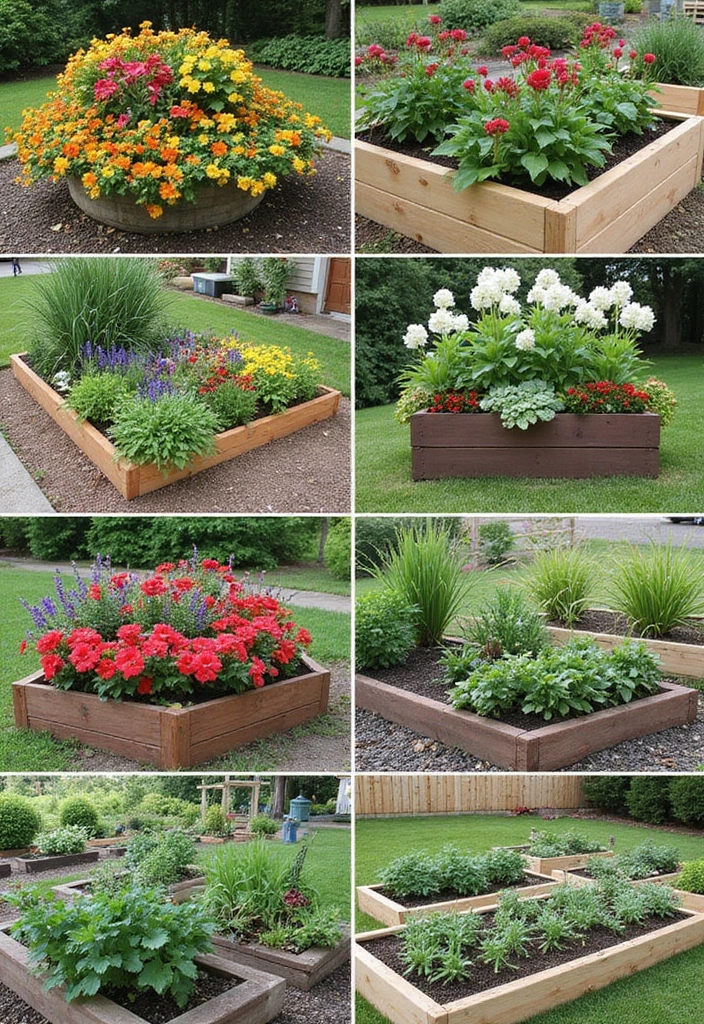
The world of raised garden beds is vast, offering creative solutions for those gardening in small spaces.
From vertical designs to unique shapes, each layout provides ample opportunities for growing healthy, delicious produce.
Experimenting with these layouts not only encourages efficiency but can bring joy and beauty to your gardening experience.
Frequently Asked Questions
What are the benefits of using raised garden beds for small space gardening?
Raised garden beds are a game-changer for small space gardening! They not only maximize your planting area but also improve drainage and soil quality. With various raised garden bed designs, you can create an efficient and visually appealing garden right at home. Plus, they reduce the need for bending and kneeling, making gardening more accessible and enjoyable!
How can I choose the right layout for my raised garden beds?
Choosing the right layout depends on your available space and what you want to grow! For small areas, consider vertical options like ladder planters or vertical wall gardens. If you have more space, you might enjoy U-shaped beds or grid layouts for organized planting. Assess your sunlight, accessibility, and aesthetic preferences to find the perfect fit for your garden!
What vegetables grow best in raised garden beds?
Almost any vegetable can thrive in raised garden beds! However, for small spaces, consider planting leafy greens like spinach and lettuce, root vegetables such as carrots and radishes, or compact varieties of tomatoes and peppers. Mixing in some herbs can also maximize your yield and add flavor to your meals. Remember to group plants with similar watering and sunlight needs for the best results!
How do I maintain the soil in my raised garden beds?
Maintaining healthy soil is key to a thriving garden! Regularly add organic matter like compost or well-rotted manure to enrich your soil. Practice crop rotation to prevent nutrient depletion, and consider planting cover crops during the off-season. Additionally, keep an eye on moisture levels, ensuring your beds are neither too dry nor waterlogged for optimal plant health!
Can I create a raised garden bed with recycled materials?
Absolutely! Using recycled materials like old wood, bricks, or even pallets is a fantastic way to build your raised garden beds while being environmentally friendly. Just make sure the materials are safe for growing food. This approach not only saves money but also adds a unique charm to your garden. Get creative, and enjoy the process of building your sustainable garden!
